
St. Augustine Monster
Encyclopedia
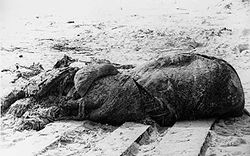
Gigantic octopus
An unknown species of gigantic octopus has been hypothesised as a source of reports of sea monsters such as the lusca and the kraken as well as the source of some of the carcasses of unidentified origin known as globsters like the St. Augustine Monster. The species that the St...
, that washed ashore on the United States
United States
The United States of America is a federal constitutional republic comprising fifty states and a federal district...
coast near St. Augustine
St. Augustine, Florida
St. Augustine is a city in the northeast section of Florida and the county seat of St. Johns County, Florida, United States. Founded in 1565 by Spanish explorer and admiral Pedro Menéndez de Avilés, it is the oldest continuously occupied European-established city and port in the continental United...
, Florida
Florida
Florida is a state in the southeastern United States, located on the nation's Atlantic and Gulf coasts. It is bordered to the west by the Gulf of Mexico, to the north by Alabama and Georgia and to the east by the Atlantic Ocean. With a population of 18,801,310 as measured by the 2010 census, it...
, in 1896. It is sometimes referred to as the Florida Monster or St. Augustine Giant Octopus, and is one of the earliest recorded examples of a globster
Globster
A globster, or blob, is an unidentified organic mass that washes up on the shoreline of an ocean or other body of water. The term was coined by Ivan T. Sanderson in 1962 to describe the Tasmanian carcass of 1960, which was said to have "no visible eyes, no defined head, and no apparent bone...
. The species that the carcass supposedly represented has been assigned the binomial names "Octopus giganteus" (Latin
Latin
Latin is an Italic language originally spoken in Latium and Ancient Rome. It, along with most European languages, is a descendant of the ancient Proto-Indo-European language. Although it is considered a dead language, a number of scholars and members of the Christian clergy speak it fluently, and...
for "giant octopus") and "Otoctopus giganteus" (Greek
Greek language
Greek is an independent branch of the Indo-European family of languages. Native to the southern Balkans, it has the longest documented history of any Indo-European language, spanning 34 centuries of written records. Its writing system has been the Greek alphabet for the majority of its history;...
prefix
Prefix
A prefix is an affix which is placed before the root of a word. Particularly in the study of languages,a prefix is also called a preformative, because it alters the form of the words to which it is affixed.Examples of prefixes:...
: oton = ear; "giant-eared octopus"), although these are not valid under the rules of the ICZN
International Code of Zoological Nomenclature
The International Code of Zoological Nomenclature is a widely accepted convention in zoology that rules the formal scientific naming of organisms treated as animals...
.
Recent analysis concludes that the St. Augustine Monster was a large mass of the collagen
Collagen
Collagen is a group of naturally occurring proteins found in animals, especially in the flesh and connective tissues of mammals. It is the main component of connective tissue, and is the most abundant protein in mammals, making up about 25% to 35% of the whole-body protein content...
ous matrix of whale
Whale
Whale is the common name for various marine mammals of the order Cetacea. The term whale sometimes refers to all cetaceans, but more often it excludes dolphins and porpoises, which belong to suborder Odontoceti . This suborder also includes the sperm whale, killer whale, pilot whale, and beluga...
blubber
Blubber
Blubber is a thick layer of vascularized adipose tissue found under the skin of all cetaceans, pinnipeds and sirenians.-Description:Lipid-rich, collagen fiber–laced blubber comprises the hypodermis and covers the whole body, except for parts of the appendages, strongly attached to the musculature...
, likely from a sperm whale
Sperm Whale
The sperm whale, Physeter macrocephalus, is a marine mammal species, order Cetacea, a toothed whale having the largest brain of any animal. The name comes from the milky-white waxy substance, spermaceti, found in the animal's head. The sperm whale is the only living member of genus Physeter...
.
Discovery

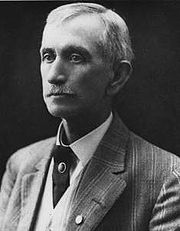
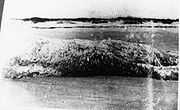





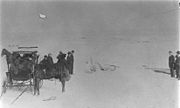
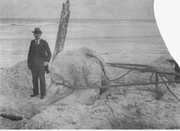
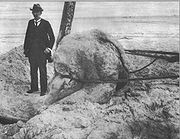
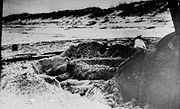
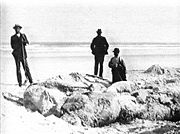
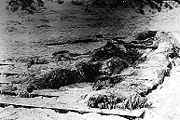
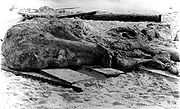
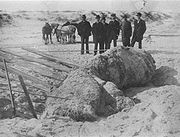


Initial stranding
The carcass was first spotted on the evening of November 30, 1896 by two young boys, Herbert Coles and Dunham Coretter, while bicycling along Anastasia IslandAnastasia Island
Anastasia Island is a barrier island which is approximately long located off the northeast Atlantic coast of Florida in the United States. The island is located east and southeast of St. Augustine. It is separated from the mainland by the Matanzas River, part of the Intracoastal waterway, Matanzas...
. The enormous mass was half buried in the sand, having sunk under its immense weight. The two boys thought the carcass was the remains of a beached whale, as a similar stranding had occurred two years earlier near the mouth of the Matanzas River
Matanzas River
Matanzas River is a body of water located in St. Johns and Flagler counties in Florida. It is a narrow saltwater bar-bounded estuary sheltered from the Atlantic Ocean by Anastasia Island....
, located several miles to the south of St. Augustine (see map).
The two boys returned to St. Augustine the same day and reported their discovery to a local physician, Dr. DeWitt Webb
DeWitt Webb
Dr. DeWitt Webb was a physician, amateur naturalist, and the founder of the St. Augustine Historical Society and Institute of Science. He was the president of the society for 34 years. Webb was a member of the Florida State Legislature and the mayor of the town of St...
. Webb, who was the founder of the St. Augustine Historical Society and Institute of Science, came to the beach the following day, December 1, to examine the remains. He would be the only person of an academic background to see the specimen in situ
In situ
In situ is a Latin phrase which translated literally as 'In position'. It is used in many different contexts.-Aerospace:In the aerospace industry, equipment on board aircraft must be tested in situ, or in place, to confirm everything functions properly as a system. Individually, each piece may...
.
His first impression was that it was the remains of an animal, very mutilated, and in an advanced state of decomposition. The carcass was very pale pink, almost white, in colour, with a silver reflection in the sunlight. It was composed of a rubbery substance of a very hard consistency, such that it could only be cut with great difficulty. The part of the carcass that was visible measured 18 feet (approx. 6 meters) in length and 7 feet (approx. 2½ meters) in width. Webb estimated its weight at nearly 5 tons, if not more. He believed it was the remains of a giant octopus, as it appeared to have the stumps of four arms, with another arm buried nearby.
A few days later, on December 7, Webb engaged two hobbyists, Edgar Van Horn and Ernest Howatt, to photograph the carcass for posterity. At least two photographs were taken, one of the lateral view and one of the anterior view, showing the apparent arm stumps. The latter also included a man, likely DeWitt Webb himself, for scale. As the images were over-exposed, they were never published. These photographs were for a long time considered lost, and only drawings based on them, made by Alpheus Hyatt Verrill
Alpheus Hyatt Verrill
Alpheus Hyatt Verrill, known as Hyatt Verrill, was an American archaeologist, explorer, inventor, illustrator and author. He was the son of Addison Emery Verrill , the first professor of zoology at Yale University.Hyatt Verrill wrote on a wide variety of topics, including natural history, travel,...
and published in the American Naturalist
American Naturalist
The American Naturalist is a monthly peer-reviewed scientific journal that was established in 1867. It is published by the University of Chicago Press on behalf of the American Society of Naturalists. The journal covers research in ecology, evolutionary biology, population, and integrative biology....
of April 1897, were known. However, one of the original images, showing the lateral view, was obtained by Gary Mangiacopra in 1994. It is clear that one of Verrill's drawings was based on this photograph. A simplified drawing of this image also appeared in the Hartford Daily Running of February 18, 1897.
Around the same time, a certain Mr. Wilson wrote a memorandum
Memorandum
A memorandum is from the Latin verbal phrase memorandum est, the gerundive form of the verb memoro, "to mention, call to mind, recount, relate", which means "It must be remembered ..."...
to Webb, communicating the results of his observations made after having dug around the corpse. It read:
One arm lying west of the body, 23 feet long; one stump of arm about 4 feet long; three arms lying south of body and from appearance attached to same (although I did not dig quite to body, as it laid well down in the sand and I was very tired), longest one measured over 23 feet, the other arms were three to five feet shorter.
In the first days of December 1896, Dr. George Grant, owner of a hotel at South Beach on Anastasia Island, wrote a short article describing the carcass, which was published in the Pennsylvania Grit of Williamsport
Williamsport, Pennsylvania
Williamsport is a city in and the county seat of Lycoming County, Pennsylvania in the United States. In 2009, the population was estimated at 29,304...
on December 13. The article was accompanied by a picture of the "sea monster" depicting a tentacled creature with a tail. This was drawn by the draughtsman
Technical drawing
Technical drawing, also known as drafting or draughting, is the act and discipline of composing plans that visually communicate how something functions or has to be constructed.Drafting is the language of industry....
of the newspaper based on Grant's description, and not an eyewitness. Grant's description was as follows:
The head is as large as an ordinary flour barrel, and has the shape of a sea lion head. The neck, if the creature may be said to have a neck, is of the same diameter as the body. The mouth is on the under side of the head and is protected by two tentacle tubes about eight inches in diameter and about 30 feet long. These tubes resemble an elephant's trunk and obviously were used to clutch in a sucker like fashion any object within their reach.
Another tube or tentacle of the same dimensions stands out on the top of the head. Two others, one on each side, protrude from beyond the monster's neck, and extend fully 15 feet along the body and beyond the tail. The tail, which is separated and jagged with cutting points for several feet, is flanked with two more tentacles of the same dimensions as the others and 30 feet long. The eyes are under the back of the mouth instead of over it.
This specimen is so badly cut up by sharks and sawfish that only the stumps of the tentacles remain, but pieces of them were found strewn for some distance on the beach, showing that the animal had a fierce battle with its foes before it was disabled and beached by the surf.
Grant describes the animal as having seven "tentacles" and a "tail". If the "tail" is interpreted as another tentacle, giving a total of eight, this would suggest an octopus as opposed to a decapod
Decapodiformes
Decapodiformes is a superorder of Cephalopoda, which includes all species with ten limbs; the name derives from the Greek word meaning ten feet. The ten limbs are divided into 8 short arms and 2 long tentacles. It is presumed that an ancestral coleoid had five identical pairs of limbs, and that one...
such as the squid or cuttlefish
Cuttlefish
Cuttlefish are marine animals of the order Sepiida. They belong to the class Cephalopoda . Despite their name, cuttlefish are not fish but molluscs....
. Furthermore, nothing in the description indicates the presence of the long feeding tentacles found in squid, as the "tentacles" are said to be of the same dimensions.
Second stranding
Between January 9 and January 15, a storm tide dragged the carcass out to sea, but it washed ashore again on the next tide, on Crescent BeachCrescent Beach, Florida
Crescent Beach is an unincorporated census-designated place in St. Johns County, Florida, United States. The population was 985 at the 2000 census.-Geography:Crescent Beach is located at ....
, two miles to the south of its original location. Webb sent photographs of the mass, along with a description, to Joel Asaph Allen
Joel Asaph Allen
Joel Asaph Allen was an American zoologist and ornithologist, born in Springfield, Massachusetts.He studied at Harvard University under Louis Agassiz...
of the Museum of Comparative Zoology
Museum of Comparative Zoology
The Museum of Comparative Zoology, full name "The Louis Agassiz Museum of Comparative Zoology", often abbreviated simply to "MCZ", is a zoology museum located on the grounds of Harvard University in Cambridge, Massachusetts. It is one of three museums which collectively comprise the Harvard Museum...
at Harvard
Harvard University
Harvard University is a private Ivy League university located in Cambridge, Massachusetts, United States, established in 1636 by the Massachusetts legislature. Harvard is the oldest institution of higher learning in the United States and the first corporation chartered in the country...
. Allen apparently did not respond, but Webb's letter came to the attention of Prof. Addison Emery Verrill
Addison Emery Verrill
Addison Emery Verrill was an American zoologist. He was a student of Louis Agassiz at Harvard University and graduated in 1862...
of Yale
Yale University
Yale University is a private, Ivy League university located in New Haven, Connecticut, United States. Founded in 1701 in the Colony of Connecticut, the university is the third-oldest institution of higher education in the United States...
, at that time the foremost authority on cephalopod
Cephalopod
A cephalopod is any member of the molluscan class Cephalopoda . These exclusively marine animals are characterized by bilateral body symmetry, a prominent head, and a set of arms or tentacles modified from the primitive molluscan foot...
s in the country. At first, Verrill suggested the carcass might represent the remains of a giant squid
Giant squid
The giant squid is a deep-ocean dwelling squid in the family Architeuthidae, represented by as many as eight species...
. In the January 1897 issue of the American Journal of Science
American Journal of Science
The American Journal of Science is the United States of America's longest-running scientific journal, having been published continuously since its conception in 1818 by Professor Benjamin Silliman, who edited and financed it himself...
he wrote:
The proportions [given by Webb] indicate that this might have been a squid-like form, and not an Octopus. The "breadth" is evidently that of the softened and collapsed body, and would represent an actual maximum diameter in life of at least 7 feet and a probable weight of 4 or 5 tons for the body and head. These dimensions are decidedly larger than those of any of the well-authenticated Newfoundland specimens. It is perhaps a species of Architeuthis.
Verrill soon changed his mind about the identity of the creature. In the January 3 issue of the New York Herald
New York Herald
The New York Herald was a large distribution newspaper based in New York City that existed between May 6, 1835, and 1924.-History:The first issue of the paper was published by James Gordon Bennett, Sr., on May 6, 1835. By 1845 it was the most popular and profitable daily newspaper in the UnitedStates...
, he wrote that the carcass was indeed that of a giant octopus. However, the paper did not state that Verrill was the author of the article. The article read:
Its head was nearly destroyed, and only the stumps of two arms were visible . . . The body, as it lies somewhat imbedded in the sand, is 18 feet long and about 7 feet wide, while is rises 3½ feet above the sand . . . The weight of the body and head would have been at least four or five tons. If the eight arms held the proportions usually seen in smaller species of the octopus, they would have been at least 75 to 100 feet in length and about 18 inches in diameter at the base.
On January 16, the Tatler, a local news sheet that reported on the visitors to St. Augustine hotels, ran a story about the stranded creature. It restated Verrill's original identification of the carcass as a giant squid. It read:
The wide-spread interest in the very remarkable specimen of the giant squid, now lying on the beach a few miles below the city, is mainly due to its enormous size. It is believed to be the largest specimen ever found. Its great size and immense weight have thus far prevented its being moved for a more careful examination. A dozen men with blocks and tackle not being able even to turn it over. Another effort will be made with more extensive apparatus by which it is hoped to drag it from the pit in which it now lies and placing it higher up on the beach so that a careful and thorough examination in the interest of science can be made and the exact species determined. Professor Verrill of Yale and Profs. True and Dale [Dall] of the Smithsonian are in constant correspondence with Dr. DeWitt Webb, President of the St. Augustine Scientific, Literary and Historical Society, in regard to it. Several photographs have been taken of it, but owing to its position, these have not been satisfactory. Mrs. John L. Wilson believes it to belong to an extinct species. Its hide is three and a half inches thick and its head is covered by a hood that prevents examination. Apparently it is a mass of cartilage and may have been dead in the water many days before it washed ashore on Anastasia Island.
In the February issue of the American Journal of Science, Verrill even gave the animal a scientific name, Octopus giganteus (Verrill, 1897). He also added:
It is possible that it may be related to CirroteuthisCirroteuthisCirroteuthis muelleri is one of the largest cirrate octopuses, growing to a length of 1.5 m. It is the only species of the genus Cirroteuthis.-Description:...
, and in that case the two posterior stumps, looking like arms, may be the remains of the lateral fins, for they seem too far back for the arms, unless pulled out of position. On the other hand, they seem to be too far forward for fins. So that they are probably arms twisted out of their true position.
However, having examined samples of the mass sent to him by Webb, Verrill concluded that "the creature cannot be an Octopus, but is of cetacea
Cetacea
The order Cetacea includes the marine mammals commonly known as whales, dolphins, and porpoises. Cetus is Latin and is used in biological names to mean "whale"; its original meaning, "large sea animal", was more general. It comes from Ancient Greek , meaning "whale" or "any huge fish or sea...
n nature." He suggested that "the whole mass represents the upper part of the head of [a sperm whale
Sperm Whale
The sperm whale, Physeter macrocephalus, is a marine mammal species, order Cetacea, a toothed whale having the largest brain of any animal. The name comes from the milky-white waxy substance, spermaceti, found in the animal's head. The sperm whale is the only living member of genus Physeter...
], detached from the skull and jaw."
Webb decided the carcass should be moved further inland so that it would not be lost to the sea forever. With the help of "six horses and strong tackle" it was moved several miles nearer to St. Augustine, "to the terminus of a railroad," where it was protected from the tide and drifting sand. Its final resting place was South Beach, Anastasia Island, near to the hotel of Dr. George Grant. The St. Augustine carcass became somewhat of a tourist attraction and was visited by large numbers of people. It is unknown what happened to the carcass afterwards.
Photographs of the St. Augustine carcass were for a long time thought to be lost and drawings remained the only pictorial evidence of the event. They were finally rediscovered in 1993 by Marjorie Blakoner of California
California
California is a state located on the West Coast of the United States. It is by far the most populous U.S. state, and the third-largest by land area...
, who recognised them in an old album. Van Lockwood, one of the original photographers of the St. Augustine carcass, kept an album of photos he had taken between 1885 and 1899. Upon his death, this was bequeathed to the St. Augustine Historical Society and Institute of Science, and later fell into the possession of Marjorie Blakoner.
1971 analysis
The St. Augustine carcass was largely forgotten until 1957, when Dr. Forrest Glenn Wood, a curator at the Marineland of Florida and a founding member of the International Society of Cryptozoology, became interested in the story after finding a yellowed newspaper clipping mentioning the creature. Entitled "The Facts About Florida," it read:In 1897, portions of an octopus, said to have been more gigantic than any ever before seen, were washed up on the beach at St. Augustine. Prof. Verrill, of Yale University, who examined the remains, which alone reputedly weighed over six tons, calculated that the living creature had a girth of 25 feet and tentacles 72 feet in length!
He learned that a sample of the integument was preserved in the Smithsonian Institution
Smithsonian Institution
The Smithsonian Institution is an educational and research institute and associated museum complex, administered and funded by the government of the United States and by funds from its endowment, contributions, and profits from its retail operations, concessions, licensing activities, and magazines...
, and persuaded the curators to send a portion of the sample to his colleague, Dr. Joseph F. Gennaro Jr., a cell biologist at the University of Florida
University of Florida
The University of Florida is an American public land-grant, sea-grant, and space-grant research university located on a campus in Gainesville, Florida. The university traces its historical origins to 1853, and has operated continuously on its present Gainesville campus since September 1906...
. Gennaro compared the connective tissue of the St. Augustine carcass to control specimens from known octopus
Octopus
The octopus is a cephalopod mollusc of the order Octopoda. Octopuses have two eyes and four pairs of arms, and like other cephalopods they are bilaterally symmetric. An octopus has a hard beak, with its mouth at the center point of the arms...
and squid
Squid
Squid are cephalopods of the order Teuthida, which comprises around 300 species. Like all other cephalopods, squid have a distinct head, bilateral symmetry, a mantle, and arms. Squid, like cuttlefish, have eight arms arranged in pairs and two, usually longer, tentacles...
species. He published his findings in the March 1971 issue of Natural History
Natural History (magazine)
Natural History is an American natural history magazine. The stated mission of the magazine is to promote public understanding and appreciation of nature and science.- History :...
:
Now differences between the contemporary squid and octopus samples became very clear. In the octopus, broad bands of fibers passed across the plane of the tissue and were separated by equally broad bands arranged in a perpendicular direction. In the squid there were narrower but also relatively broad bundles arranged in the plane of the section, separated by thin partitions of perpendicular fibers.
It seemed I had found a means to identify the mystery sample after all. I could distinguish between octopus and squid, and between them and mammals, which display a lacy network of connective tissue fibers.
After 75 years, the moment of truth was at hand. Viewing section after section of the St. Augustine samples, we decided at once, and beyond any doubt, that the sample was not whale blubber. Further, the connective tissue pattern was that of broad bands in the plane of the section with equally broad bands arranged perpendicularly, a structure similar to, if not identical with, that in my octopus sample.
The evidence appears unmistakable that the St. Augustine sea monster was in fact an octopus, but the implications are fantastic. Even though the sea presents us from time to time with strange and astonishing phenomena, the idea of a gigantic octopus, with arms 75 to 100 feet in length and about 18 inches in diameter at the base—a total spread of some 200 feet—is difficult to comprehend.
1986 analysis
Roy MackalRoy Mackal
Roy P. Mackal is a retired University of Chicago biologist best known to the general public for his interest in the Loch Ness Monster and other cryptozoological entities.-Academic background:...
, a biochemist at the University of Chicago
University of Chicago
The University of Chicago is a private research university in Chicago, Illinois, USA. It was founded by the American Baptist Education Society with a donation from oil magnate and philanthropist John D. Rockefeller and incorporated in 1890...
and a founding member of the International Society of Cryptozoology (as was F. G. Wood), decided to test the samples himself. In an issue of Cryptozoology in 1986, he wrote, "Gennaro carried out comparative histological examination of the tissue, and concluded that it most resembled contemporary octopus tissue. While these results were highly suggestive, further biochemical work was required for an unambiguous identification of the tissue." Mackal tested samples of the St. Augustine carcass for different amino acid
Amino acid
Amino acids are molecules containing an amine group, a carboxylic acid group and a side-chain that varies between different amino acids. The key elements of an amino acid are carbon, hydrogen, oxygen, and nitrogen...
s and compared the results with the known amino acid composition of the tissues of a spotted dolphin
Pantropical Spotted Dolphin
The Pantropical Spotted Dolphin is a species of dolphin found in all the world's temperate and tropical oceans. The species was beginning to come under threat due to the killing of millions of individuals in tuna purse seines...
, a beluga, a giant squid
Giant squid
The giant squid is a deep-ocean dwelling squid in the family Architeuthidae, represented by as many as eight species...
, and two species of octopus.
| sample | 1M | 2M | 3M | 4M | 5M | 6M |
|---|---|---|---|---|---|---|
| aspartic acid Aspartic acid Aspartic acid is an α-amino acid with the chemical formula HOOCCHCH2COOH. The carboxylate anion, salt, or ester of aspartic acid is known as aspartate. The L-isomer of aspartate is one of the 20 proteinogenic amino acids, i.e., the building blocks of proteins... |
10.5 | 5.9 | 10.5 | 11.7 | 10.3 | 10.5 |
| threonine Threonine Threonine is an α-amino acid with the chemical formula HO2CCHCHCH3. Its codons are ACU, ACA, ACC, and ACG. This essential amino acid is classified as polar... |
4.6 | 2.5 | 4.9 | 5.4 | 4.8 | 4.6 |
| serine Serine Serine is an amino acid with the formula HO2CCHCH2OH. It is one of the proteinogenic amino acids. By virtue of the hydroxyl group, serine is classified as a polar amino acid.-Occurrence and biosynthesis:... |
7.1 | 3.9 | 6.0 | 5.8 | 5.5 | 8.0 |
| glutamic acid Glutamic acid Glutamic acid is one of the 20 proteinogenic amino acids, and its codons are GAA and GAG. It is a non-essential amino acid. The carboxylate anions and salts of glutamic acid are known as glutamates... |
17.7 | 8.8 | 14.2 | 16.6 | 12.6 | 16.7 |
| hydroxyproline Hydroxyproline -4-Hydroxyproline, or L-hydroxyproline , is a common non-proteinogenic amino acid, abbreviated as HYP, e.g., in Protein Data Bank.-Structure and discovery:... |
not made | not made | not made | not made | not made | not made |
| proline Proline Proline is an α-amino acid, one of the twenty DNA-encoded amino acids. Its codons are CCU, CCC, CCA, and CCG. It is not an essential amino acid, which means that the human body can synthesize it. It is unique among the 20 protein-forming amino acids in that the α-amino group is secondary... |
4.7 | 16.8 | 6.3 | 4.7 | 6.5 | 4.3 |
| glycine Glycine Glycine is an organic compound with the formula NH2CH2COOH. Having a hydrogen substituent as its 'side chain', glycine is the smallest of the 20 amino acids commonly found in proteins. Its codons are GGU, GGC, GGA, GGG cf. the genetic code.Glycine is a colourless, sweet-tasting crystalline solid... |
10.6 | 34.6 | 19.2 | 11.5 | 20.0 | 14.2 |
| alanine Alanine Alanine is an α-amino acid with the chemical formula CH3CHCOOH. The L-isomer is one of the 20 amino acids encoded by the genetic code. Its codons are GCU, GCC, GCA, and GCG. It is classified as a nonpolar amino acid... |
7.5 | 13.4 | 8.6 | 9.5 | 8.6 | 7.6 |
| valine Valine Valine is an α-amino acid with the chemical formula HO2CCHCH2. L-Valine is one of 20 proteinogenic amino acids. Its codons are GUU, GUC, GUA, and GUG. This essential amino acid is classified as nonpolar... |
6.6 | 2.4 | 4.8 | 5.5 | 5.3 | 6.4 |
| methionine Methionine Methionine is an α-amino acid with the chemical formula HO2CCHCH2CH2SCH3. This essential amino acid is classified as nonpolar. This amino-acid is coded by the codon AUG, also known as the initiation codon, since it indicates mRNA's coding region where translation into protein... |
2.2 | 0.4 | 1.9 | 2.2 | 1.9 | 2.1 |
| isoleucine Isoleucine Isoleucine is an α-amino acid with the chemical formula HO2CCHCHCH2CH3. It is an essential amino acid, which means that humans cannot synthesize it, so it must be ingested. Its codons are AUU, AUC and AUA.... |
5.1 | 1.2 | 4.9 | 5.9 | 5.4 | 4.6 |
| leucine Leucine Leucine is a branched-chain α-amino acid with the chemical formula HO2CCHCH2CH2. Leucine is classified as a hydrophobic amino acid due to its aliphatic isobutyl side chain. It is encoded by six codons and is a major component of the subunits in ferritin, astacin and other 'buffer' proteins... |
10.7 | 2.9 | 7.8 | 10.0 | 8.1 | 10.4 |
| tyrosine Tyrosine Tyrosine or 4-hydroxyphenylalanine, is one of the 22 amino acids that are used by cells to synthesize proteins. Its codons are UAC and UAU. It is a non-essential amino acid with a polar side group... |
1.2 | 0.0 | 0.7 | 0.6 | 0.5 | 1.4 |
| phenylalanine Phenylalanine Phenylalanine is an α-amino acid with the formula C6H5CH2CHCOOH. This essential amino acid is classified as nonpolar because of the hydrophobic nature of the benzyl side chain. L-Phenylalanine is an electrically neutral amino acid, one of the twenty common amino acids used to biochemically form... |
3.1 | 1.5 | 2.6 | 3.0 | 3.2 | 3.5 |
| histidine Histidine Histidine Histidine, an essential amino acid, has a positively charged imidazole functional group. It is one of the 22 proteinogenic amino acids. Its codons are CAU and CAC. Histidine was first isolated by German physician Albrecht Kossel in 1896. Histidine is an essential amino acid in humans... |
0.3 | 0.0 | 0.2 | |||
| lysine Lysine Lysine is an α-amino acid with the chemical formula HO2CCH4NH2. It is an essential amino acid, which means that the human body cannot synthesize it. Its codons are AAA and AAG.... |
1.6 | 0.0 | 1.0 | 0.9 | 0.8 | 0.5 |
| arginine Arginine Arginine is an α-amino acid. The L-form is one of the 20 most common natural amino acids. At the level of molecular genetics, in the structure of the messenger ribonucleic acid mRNA, CGU, CGC, CGA, CGG, AGA, and AGG, are the triplets of nucleotide bases or codons that codify for arginine during... |
6.4 | 5.8 | 6.6 | 6.7 | 6.5 | 5.2 |
| hydroxylysine Hydroxylysine 5-Hydroxylysine is an amino acid with the molecular formula C6H14N2O3. It was first discovered in 1921 by Donald Van Slyke. It is a hydroxy derivative of lysine. It is most widely known as a component of collagen.... |
0.0 | 0.0 | 0.0 | 0.0 | 0.0 | 0.0 |
| sample | Weight (mg) | Cu (ppm) | Fe (ppm) | Cu/Fe |
|---|---|---|---|---|
| 1M | 12.8 | 300 | 1600 | 0.19 |
| 2M | 29.1 | 60 | 200 | 0.30 |
| 4M | 5.6 | 240 | 560 | 0.43 |
| 6M | 10.5 | 330 | 470 | 0.70 |
He published his findings in Cryptozoology:
On the basis of Gennaro's histological studies and the present amino acid and CuCopperCopper is a chemical element with the symbol Cu and atomic number 29. It is a ductile metal with very high thermal and electrical conductivity. Pure copper is soft and malleable; an exposed surface has a reddish-orange tarnish...
and FeIronIron is a chemical element with the symbol Fe and atomic number 26. It is a metal in the first transition series. It is the most common element forming the planet Earth as a whole, forming much of Earth's outer and inner core. It is the fourth most common element in the Earth's crust...
analyses, I conclude that, to the extent the preserved O. giganteus tissue is representative of the carcass washed ashore at St. Augustine, Florida, in November 1896, it was essentially a huge mass of collagenous protein. Certainly, the tissue was not blubber. I interpret these results as consistent with, and supportive of, Webb and Verrill's identification of the carcass as that of a gigantic cephalopod, probably an octopus, not referable to any known species.
1995 analysis
Samples of the St. Augustine carcass were again examined in 1995. They were subjected to electron microscopy and biochemical analysis in what was the most thorough examination of the preserved material to date. The results of the analyses, published in the Biological Bulletin, disputed the earlier findings of Gennaro and Mackal. These are shown in the following table: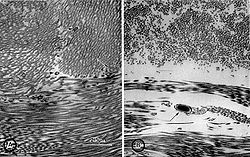
| Amino acid | Bermuda carcass | St. Augustine carcass | Octopus mantle1 | Squid mantle2 | Carp3 | Whale skin4 | Shark skin5 |
|---|---|---|---|---|---|---|---|
| Asp Aspartic acid Aspartic acid is an α-amino acid with the chemical formula HOOCCHCH2COOH. The carboxylate anion, salt, or ester of aspartic acid is known as aspartate. The L-isomer of aspartate is one of the 20 proteinogenic amino acids, i.e., the building blocks of proteins... |
52 | 50 | 53 | 58 | 48 | 46 | 43 |
| Thr Threonine Threonine is an α-amino acid with the chemical formula HO2CCHCHCH3. Its codons are ACU, ACA, ACC, and ACG. This essential amino acid is classified as polar... |
27 | 28 | 28 | 26 | 25 | 24 | 23 |
| Ser Serine Serine is an amino acid with the formula HO2CCHCH2OH. It is one of the proteinogenic amino acids. By virtue of the hydroxyl group, serine is classified as a polar amino acid.-Occurrence and biosynthesis:... |
47 | 45 | 52 | 47 | 43 | 41 | 61 |
| OH-Pro Proline Proline is an α-amino acid, one of the twenty DNA-encoded amino acids. Its codons are CCU, CCC, CCA, and CCG. It is not an essential amino acid, which means that the human body can synthesize it. It is unique among the 20 protein-forming amino acids in that the α-amino group is secondary... |
79 | 54 | 95 | 89 | 82 | 89 | 60 |
| Pro Proline Proline is an α-amino acid, one of the twenty DNA-encoded amino acids. Its codons are CCU, CCC, CCA, and CCG. It is not an essential amino acid, which means that the human body can synthesize it. It is unique among the 20 protein-forming amino acids in that the α-amino group is secondary... |
88 | 169 | 101 | 96 | 117 | 128 | 106 |
| Glu Glutamic acid Glutamic acid is one of the 20 proteinogenic amino acids, and its codons are GAA and GAG. It is a non-essential amino acid. The carboxylate anions and salts of glutamic acid are known as glutamates... |
83 | 82 | 64 | 86 | 69 | 70 | 68 |
| Gly Glycine Glycine is an organic compound with the formula NH2CH2COOH. Having a hydrogen substituent as its 'side chain', glycine is the smallest of the 20 amino acids commonly found in proteins. Its codons are GGU, GGC, GGA, GGG cf. the genetic code.Glycine is a colourless, sweet-tasting crystalline solid... |
339 | 330 | 324 | 308 | 326 | 326 | 338 |
| Ala Alanine Alanine is an α-amino acid with the chemical formula CH3CHCOOH. The L-isomer is one of the 20 amino acids encoded by the genetic code. Its codons are GCU, GCC, GCA, and GCG. It is classified as a nonpolar amino acid... |
113 | 106 | 100 | 89 | 119 | 111 | 106 |
| Val Valine Valine is an α-amino acid with the chemical formula HO2CCHCH2. L-Valine is one of 20 proteinogenic amino acids. Its codons are GUU, GUC, GUA, and GUG. This essential amino acid is classified as nonpolar... |
25 | 18 | 19 | 21 | 18 | 21 | 25 |
| Cys Cysteine Cysteine is an α-amino acid with the chemical formula HO2CCHCH2SH. It is a non-essential amino acid, which means that it is biosynthesized in humans. Its codons are UGU and UGC. The side chain on cysteine is thiol, which is polar and thus cysteine is usually classified as a hydrophilic amino acid... |
0 | 0 | 8 | 4 | 0 | 0 | 0 |
| Met Methionine Methionine is an α-amino acid with the chemical formula HO2CCHCH2CH2SCH3. This essential amino acid is classified as nonpolar. This amino-acid is coded by the codon AUG, also known as the initiation codon, since it indicates mRNA's coding region where translation into protein... |
0 | 0 | 6 | 8 | 14 | 5 | 18 |
| Ileu Isoleucine Isoleucine is an α-amino acid with the chemical formula HO2CCHCHCH2CH3. It is an essential amino acid, which means that humans cannot synthesize it, so it must be ingested. Its codons are AUU, AUC and AUA.... |
14 | 11 | 22 | 21 | 11 | 11 | 15 |
| Leu Leucine Leucine is a branched-chain α-amino acid with the chemical formula HO2CCHCH2CH2. Leucine is classified as a hydrophobic amino acid due to its aliphatic isobutyl side chain. It is encoded by six codons and is a major component of the subunits in ferritin, astacin and other 'buffer' proteins... |
32 | 28 | 30 | 32 | 22 | 25 | 25 |
| Tyr Tyrosine Tyrosine or 4-hydroxyphenylalanine, is one of the 22 amino acids that are used by cells to synthesize proteins. Its codons are UAC and UAU. It is a non-essential amino acid with a polar side group... |
0 | 0 | 5 | 5 | 3 | 4 | 3 |
| Phe Phenylalanine Phenylalanine is an α-amino acid with the formula C6H5CH2CHCOOH. This essential amino acid is classified as nonpolar because of the hydrophobic nature of the benzyl side chain. L-Phenylalanine is an electrically neutral amino acid, one of the twenty common amino acids used to biochemically form... |
16 | 14 | 8 | 12 | 14 | 13 | 13 |
| OH-Lys Lysine Lysine is an α-amino acid with the chemical formula HO2CCH4NH2. It is an essential amino acid, which means that the human body cannot synthesize it. Its codons are AAA and AAG.... |
13.1 | 15.3 | 15.7 | 16.1 | 7.1 | 6 | 5.5 |
| Lys Lysine Lysine is an α-amino acid with the chemical formula HO2CCH4NH2. It is an essential amino acid, which means that the human body cannot synthesize it. Its codons are AAA and AAG.... |
10 | 0.4 | 11 | 15 | 25 | 26 | 27 |
| His Histidine Histidine Histidine, an essential amino acid, has a positively charged imidazole functional group. It is one of the 22 proteinogenic amino acids. Its codons are CAU and CAC. Histidine was first isolated by German physician Albrecht Kossel in 1896. Histidine is an essential amino acid in humans... |
6 | 4 | 3 | 7 | 5 | 6 | 13 |
| Arg Arginine Arginine is an α-amino acid. The L-form is one of the 20 most common natural amino acids. At the level of molecular genetics, in the structure of the messenger ribonucleic acid mRNA, CGU, CGC, CGA, CGG, AGA, and AGG, are the triplets of nucleotide bases or codons that codify for arginine during... |
55 | 48 | 58 | 59 | 52 | 50 | 51 |
The samples were found to be "masses of virtually pure collagen" and not to have the "biochemical characteristics of invertebrate collagen, nor the collagen fiber arrangement of octopus mantle." The results suggest the samples are "the remains of the skin of an enormous warm-blooded
Warm-blooded
The term warm-blooded is a colloquial term to describe animal species which have a relatively higher blood temperature, and maintain thermal homeostasis primarily through internal metabolic processes...
vertebrate
Vertebrate
Vertebrates are animals that are members of the subphylum Vertebrata . Vertebrates are the largest group of chordates, with currently about 58,000 species described. Vertebrates include the jawless fishes, bony fishes, sharks and rays, amphibians, reptiles, mammals, and birds...
." The authors conclude that "there is no evidence to support the existence of Octopus giganteus" and concur with Verrill (1897) and Lucas (1897) that the St. Augustine carcass was "the remains of a whale
Whale
Whale is the common name for various marine mammals of the order Cetacea. The term whale sometimes refers to all cetaceans, but more often it excludes dolphins and porpoises, which belong to suborder Odontoceti . This suborder also includes the sperm whale, killer whale, pilot whale, and beluga...
, likely the entire skin
Blubber
Blubber is a thick layer of vascularized adipose tissue found under the skin of all cetaceans, pinnipeds and sirenians.-Description:Lipid-rich, collagen fiber–laced blubber comprises the hypodermis and covers the whole body, except for parts of the appendages, strongly attached to the musculature...
layer] . . . nothing more or less."
2004 analysis
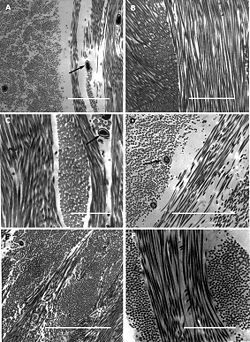
| Amino acid | Chilean | St Augustinea | Bermuda 1a | Bermuda 2 | Tasmanian | Nantucket |
|---|---|---|---|---|---|---|
| Asp Aspartic acid Aspartic acid is an α-amino acid with the chemical formula HOOCCHCH2COOH. The carboxylate anion, salt, or ester of aspartic acid is known as aspartate. The L-isomer of aspartate is one of the 20 proteinogenic amino acids, i.e., the building blocks of proteins... |
28 | 50 | 52 | 42 | 31 | 45 |
| Thr Threonine Threonine is an α-amino acid with the chemical formula HO2CCHCHCH3. Its codons are ACU, ACA, ACC, and ACG. This essential amino acid is classified as polar... |
22 | 28 | 27 | 19 | 19 | 23 |
| Ser Serine Serine is an amino acid with the formula HO2CCHCH2OH. It is one of the proteinogenic amino acids. By virtue of the hydroxyl group, serine is classified as a polar amino acid.-Occurrence and biosynthesis:... |
40 | 45 | 47 | 36 | 50 | 35 |
| OH-Pro Proline Proline is an α-amino acid, one of the twenty DNA-encoded amino acids. Its codons are CCU, CCC, CCA, and CCG. It is not an essential amino acid, which means that the human body can synthesize it. It is unique among the 20 protein-forming amino acids in that the α-amino group is secondary... |
90 | 54 | 79 | 113 | 84 | 146 |
| Pro Proline Proline is an α-amino acid, one of the twenty DNA-encoded amino acids. Its codons are CCU, CCC, CCA, and CCG. It is not an essential amino acid, which means that the human body can synthesize it. It is unique among the 20 protein-forming amino acids in that the α-amino group is secondary... |
213 | 169 | 88 | 182 | 92 | 136 |
| Glu Glutamic acid Glutamic acid is one of the 20 proteinogenic amino acids, and its codons are GAA and GAG. It is a non-essential amino acid. The carboxylate anions and salts of glutamic acid are known as glutamates... |
63 | 82 | 83 | 62 | 78 | 63 |
| Gly Glycine Glycine is an organic compound with the formula NH2CH2COOH. Having a hydrogen substituent as its 'side chain', glycine is the smallest of the 20 amino acids commonly found in proteins. Its codons are GGU, GGC, GGA, GGG cf. the genetic code.Glycine is a colourless, sweet-tasting crystalline solid... |
314 | 330 | 339 | 298 | 363 | 280 |
| Ala Alanine Alanine is an α-amino acid with the chemical formula CH3CHCOOH. The L-isomer is one of the 20 amino acids encoded by the genetic code. Its codons are GCU, GCC, GCA, and GCG. It is classified as a nonpolar amino acid... |
96 | 106 | 113 | 94 | 133 | 94 |
| Val Valine Valine is an α-amino acid with the chemical formula HO2CCHCH2. L-Valine is one of 20 proteinogenic amino acids. Its codons are GUU, GUC, GUA, and GUG. This essential amino acid is classified as nonpolar... |
13 | 18 | 25 | 21 | 22 | 22 |
| Cys Cysteine Cysteine is an α-amino acid with the chemical formula HO2CCHCH2SH. It is a non-essential amino acid, which means that it is biosynthesized in humans. Its codons are UGU and UGC. The side chain on cysteine is thiol, which is polar and thus cysteine is usually classified as a hydrophilic amino acid... |
0 | 0 | 0 | 0 | 0 | 0 |
| Met Methionine Methionine is an α-amino acid with the chemical formula HO2CCHCH2CH2SCH3. This essential amino acid is classified as nonpolar. This amino-acid is coded by the codon AUG, also known as the initiation codon, since it indicates mRNA's coding region where translation into protein... |
4 | 0 | 0 | 3 | 1 | 3 |
| Ile Isoleucine Isoleucine is an α-amino acid with the chemical formula HO2CCHCHCH2CH3. It is an essential amino acid, which means that humans cannot synthesize it, so it must be ingested. Its codons are AUU, AUC and AUA.... |
8 | 11 | 14 | 10 | 11 | 11 |
| Leu Leucine Leucine is a branched-chain α-amino acid with the chemical formula HO2CCHCH2CH2. Leucine is classified as a hydrophobic amino acid due to its aliphatic isobutyl side chain. It is encoded by six codons and is a major component of the subunits in ferritin, astacin and other 'buffer' proteins... |
25 | 28 | 32 | 23 | 30 | 25 |
| Tyr Tyrosine Tyrosine or 4-hydroxyphenylalanine, is one of the 22 amino acids that are used by cells to synthesize proteins. Its codons are UAC and UAU. It is a non-essential amino acid with a polar side group... |
3 | 0 | 0 | 0 | 0 | 6 |
| Phe Phenylalanine Phenylalanine is an α-amino acid with the formula C6H5CH2CHCOOH. This essential amino acid is classified as nonpolar because of the hydrophobic nature of the benzyl side chain. L-Phenylalanine is an electrically neutral amino acid, one of the twenty common amino acids used to biochemically form... |
12 | 14 | 16 | 12 | 15 | 14 |
| OH-Lys Lysine Lysine is an α-amino acid with the chemical formula HO2CCH4NH2. It is an essential amino acid, which means that the human body cannot synthesize it. Its codons are AAA and AAG.... |
11 | 15 | 13 | 26 | 7 | 20 |
| Lys Lysine Lysine is an α-amino acid with the chemical formula HO2CCH4NH2. It is an essential amino acid, which means that the human body cannot synthesize it. Its codons are AAA and AAG.... |
21 | 0.4 | 10 | 18 | 12 | 25 |
| His Histidine Histidine Histidine, an essential amino acid, has a positively charged imidazole functional group. It is one of the 22 proteinogenic amino acids. Its codons are CAU and CAC. Histidine was first isolated by German physician Albrecht Kossel in 1896. Histidine is an essential amino acid in humans... |
6 | 4 | 6 | 0 | 0 | 8 |
| Arg Arginine Arginine is an α-amino acid. The L-form is one of the 20 most common natural amino acids. At the level of molecular genetics, in the structure of the messenger ribonucleic acid mRNA, CGU, CGC, CGA, CGG, AGA, and AGG, are the triplets of nucleotide bases or codons that codify for arginine during... |
29 | 48 | 55 | 42 | 51 | 45 |
See also
- Giant octopusGiant octopusEnteroctopus is an octopus genus, many of whose members are sometimes known as giant octopuses.- Description :Enteroctopus is a genus of generally temperate octopuses. Members of the genus Enteroctopus are characterized by their large size and are often known as the giant octopuses...
es, members of the genus Enteroctopus - Seven-arm OctopusSeven-arm OctopusThe Seven-arm Octopus is the largest known species of octopus based on scientific records, with a total estimated length of 4 m and weight of 75 kg...
, the largest known species of octopus based on scientific records - LuscaLuscaThe lusca is a name given to a sea monster reported from the Caribbean. It has been suggested by cryptozoologists that the lusca is a gigantic octopus, far larger than the known giant octopuses of the genus Enteroctopus.-Sightings:...
, a tentacled sea monster from the Caribbean

